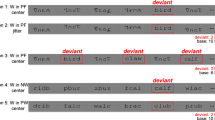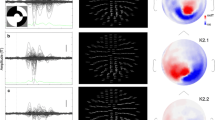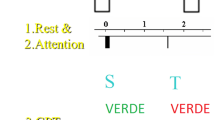Summary
Event-related potentials (ERPs) were recorded from 40 locations, covering most of the scalp, during repeated tasks in which the observer (O) had to judge either the tense of a printed verb (V) or the symmetry of a spatial pattern (S). Stimuli were drawn at random from large ensembles. A simplified method of Laplacean analysis (MacKay 1983, 1984) allowed the corresponding source densities to be mapped at up to 28 locations, relatively free of artefacts due to eye movements or tongue movements. O signalled his judgment in each case by pressing one of two buttons on a given cue. The decision time allowed was kept short (about 1 s) but long enough for the task to be handled successfully. When stimuli ‘V’ and ‘S’ were drawn from geometrically different ensembles, the source-density distributions for the two tasks differed significantly at a number of locations. When ‘V’ and ‘S’ were drawn from a common ensemble, however, and O was instructed on each trial (in random order) to assess each stimulus as a word or as a geometrical pattern, the similarities in the source-density maps were more striking than the differences. It would seem that during sufficiently rapid verbal and spatial judgments, little sign of hemispheric specialization or task-specific differences may appear in the spatiotemporal profile of ERP source densities. More salient differences, some lateralized, appeared during the preparation interval prior to verbal and spatial tasks; but their pattern varied widely from subject to subject.
Similar content being viewed by others
References
Altenmueller E, Landwehrmeyer B, Jung R (1985) Electrophysiological evidence of right parietal dominance of visualspatial processing tasks. J Neurol Suppl 232: 140
Birbaumer N, Elbert T, Lutzenberger W, Rockstroh B, Schwarz J (1981) EEG and slow cortical potentials in anticipation of mental tasks with different hemispheric involvement. Biol Psychol 13: 251–260
Boddy J (1981) Evoked potentials and the dynamics of language processing. Biol Psychol 13: 125–140
Butler SR, Glass A, Heffner R (1981) Asymmetries of the contigent negative variation (CNV) and its after positive wave (APW) related to differential hemispheric involvement in verbal and non-verbal tasks. Biol Psychol 13: 157–171
Friedman D (1978) Lateral asymmetries of evoked potentials and linguistic processing. In: Otto D (ed) Multidisciplinary perspectives in event-related brain potential research. Washington, D.C.: US Government Printing Office (EDA-600/9-77-043)
Hillyard SA, Kutas M (1983) Electrophysiology of cognitive processes. Ann Rev Psychol 34: 33–61
Jung R (1984) Electrophysiological cues of the language-dominant hemisphere in man: slow brain potentials during language processing and writing. Exp Brain Res Suppl 9: 430–450
Jung R, Hufschmidt A, Moschallski W (1982) Langsame Hirnpotentiale beim Schreiben: die Wechselwirkung von Schreibhand und Sprachdominanz bei Rechtshändern. Arch Psychiatr Nervenkr 232: 305–324
Kutas M, Hillyard SA (1983) Event-related brain potentials and cognitive science. In: Gazzaniga M (ed) Cognitive neuroscience. Plenum Press, New York
McCallum WC (1979) Cognitive aspects of slow potential changes. In: Desmedt JE (ed) Cognitive components in cerebral event-related potentials and selective attention. Prog Clin Neurophys 6: 151–171
MacKay DM (1983) On-line source-density computation with a minimum of electrodes. Electroencephalogr Clin Neurophysiol 56: 696–698
MacKay DM (1984a) Source density analysis of scalp potentials during evaluated action. I. Coronal distribution. Exp Brain Res 54: 73–85
MacKay DM (1984b) Source density analysis of scalp potentials during evaluated action. II. Lateral distribution. Exp Brain Res 54: 86–94
MacKay DM (1984c) Source-density mapping of human visual receptive fields using scalp electrodes. Exp Brain Res 54: 579–581
Ornstein R, Johnstone J, Herron J, Swencionis C (1980) Differential right hemisphere engagement in visuospatial tasks. Neuropsychologia 19: 49–64
Sobatka S, Pizlo Z, Budohaska W (1984) Hemispheric differences in evoked potentials to pictures of faces in the left and right visual fields. Electroencephalogr Clin Neurophys 59: 441–453
Srebro R (1985) Localization of visually evoked cortical activity in humans. J Physiol 360: 233–246
Rebert CS, Lowe RC (1980) Task-related hemispheric asymmetry of contigent negative variation. Prog Brain Res 54: 776–781
Author information
Authors and Affiliations
Rights and permissions
About this article
Cite this article
MacKay, D.M., Ludwig, T.E. Source density analysis of scalp potentials during linguistic and non-linguistic processing of visual stimuli. Exp Brain Res 64, 451–463 (1986). https://doi.org/10.1007/BF00340481
Received:
Accepted:
Issue Date:
DOI: https://doi.org/10.1007/BF00340481




